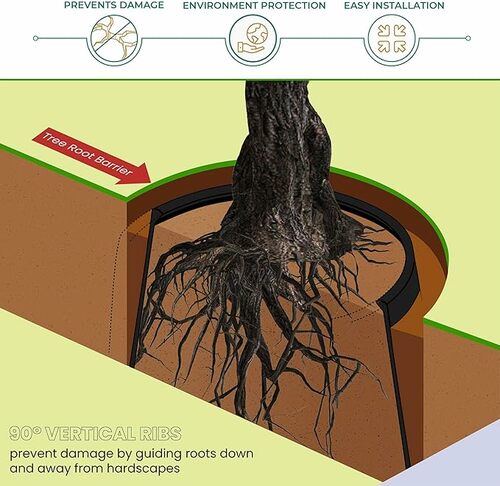Armillaria Root Rot—Its Bark Glows in the Dark!
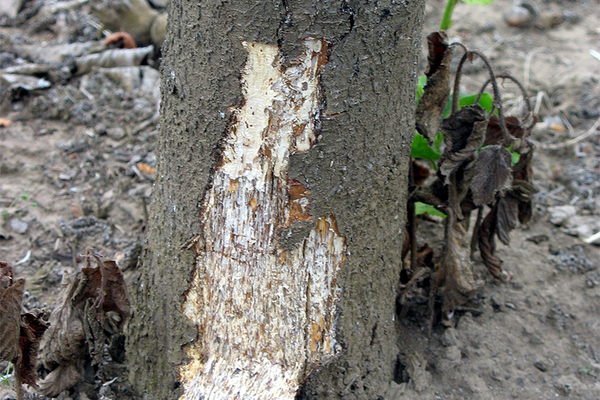
Photo: Oregon State University
Understanding Armillaria Root Rot: The Glowing Threat to Trees
In today's environmentally conscious era, widespread attention focuses on threats like the Emerald Ash Borer and Sooty Canker, devastating specific tree species. Yet, a lesser-known but equally menacing issue lurks, impacting numerous trees across varied landscapes—the Armillaria Root Rot. Despite its prevalence, this ailment often remains unidentified, contributing to the demise of countless trees in residential and professional settings.
What is Armillaria Root Rot and Its Origin?
Armillaria Root Rot, also known as oak root fungus or mushroom root rot, arises from a soil-borne fungus attacking and decomposing the roots of various plants and trees. Although it plays a vital role in forest ecosystems by breaking down deceased tree roots, it also infects live root tissue, particularly in stressed or declining trees. The fungus pervades soils once abundant with trees, such as former forests, and commonly persists in areas where urban development replaces wooded landscapes. Research indicates a scarcity of active Armillaria in previous prairies and long-established farm fields. Notably, in urban locales, oak and maple trees top the list of susceptible hosts.
The disease manifests through symptoms like faded leaf color, diminished growth vigor, wilting, and browning of leaves. Major branches can also die or show excessive signs of wilt. Affected trees, especially fruit and ornamental varieties, experience gradual decline over several seasons, hastened when coupled with insect infestation or nutrient deficiencies. We'll dive into these aspects later in the post.
The Spooky Signature of Armillaria: Luminescence
One eerie characteristic distinguishes Armillaria—its mycelium, the fungus's vegetative network of fine white filaments, emits an ethereal glow in the dark! Although the associated mushrooms exhibit minimal luminescence, pieces of wood with advanced Armillaria decay emit noticeable light in dark settings. The amount of light varies greatly from different pieces of decaying wood, but some pieces are quite bright. Other fungi glow, but Armillaria is the most common and widespread luminescent fungus. This luminescence phenomenon, termed "fairy fire" in folklore or more contemporarily known as "foxfire," has captivated imaginations for ages.
Speculation surrounds the possible benefits of luminescence. Does it attract animals that aid the fungus, or does it serve a physiological role in waste product metabolism?
Economic Ripples of Armillaria Root Rot
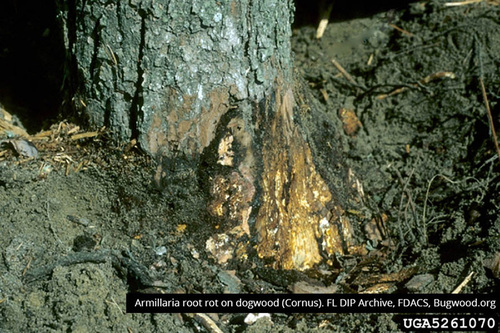
Armillaria Root Rot at the Base of a Tree Trunk
Timber Industry Woes
The timber industry stands among the most significantly affected sectors due to Armillaria Root Rot. Infested forests experience decreased timber yield and quality, impacting logging operations and wood processing industries. Affected trees, weakened by the fungus, are more susceptible to breakage, reducing the value of harvested timber and affecting the profitability of logging enterprises.
Forestry Management Costs
Furthermore, combating Armillaria outbreaks incurs substantial expenses for forest management authorities and landowners. Implementing control measures, such as selective tree removal or replanting with disease-resistant species, demands significant financial investments. These expenses strain forestry budgets and escalate operational costs, impacting the overall economic viability of forest management practices.
Ecosystem Services Disruption
Beyond the timber industry, Armillaria Root Rot disrupts ecosystem services vital for various sectors. Affected forests play crucial roles in carbon sequestration, water filtration, and soil stability. A decline in forest health due to widespread Armillaria infestation jeopardizes these ecosystem services, potentially impacting industries reliant on clean water sources, stable soil conditions, and climate regulation.
Impact on Property Values
In urban and suburban settings, where trees significantly contribute to property values and aesthetic appeal, the impact of Armillaria Root Rot can be substantial. Diseased or dying trees decrease property values, necessitating costly removal and replacement efforts. Homeowners and property developers incur expenses in managing the repercussions of tree loss and deterioration caused by the fungus.
Addressing Economic Challenges
Mitigating the economic fallout of Armillaria Root Rot necessitates a multifaceted approach. Implementing sustainable forest management practices, investing in disease-resistant tree species, and promoting early detection and intervention strategies can help curtail economic losses. Collaboration between forestry experts, researchers, and industry stakeholders is imperative to develop cost-effective solutions and minimize the financial toll of this fungal menace.
Prevention and Treatment Strategies for Armillaria Root Rot
Site Selection and Preparation
Prevention starts with site selection. When establishing new landscapes or forests, choose sites with no history of Armillaria infestation whenever possible. Conduct thorough soil testing to assess the presence of the fungus before planting trees. Prioritize well-draining soils and avoid areas prone to waterlogging, as excess moisture exacerbates fungal growth.
Healthy Tree Practices
Maintaining tree health is paramount. Ensure proper irrigation, nutrition, and adequate sunlight for trees to thrive. Regular inspections by certified arborists can detect early signs of stress or disease, allowing for timely intervention. Pruning dead or diseased branches can reduce stress and limit the fungus's potential entry points into the tree.
Resistant Species Selection
Selecting disease-resistant tree species is an effective preventive measure. Research and consult with local arborists or forestry experts to identify tree species less susceptible to Armillaria Root Rot that are prevalent in your area. Planting a diverse range of tree species can also mitigate the risk of widespread infestation.
Soil Management and Barrier Installation
Implement good soil management practices. Avoid piling mulch against tree trunks, as this can create favorable conditions for fungal growth. Installing physical barriers, like metal or plastic sheets, around the root collar of susceptible trees can help prevent direct contact between roots and the fungus in infected soil.
Fungicide Application
Fungicides may offer limited effectiveness in controlling Armillaria Root Rot. However, their application might assist in protecting trees under stress or at risk of infection. Consult with a certified arborist or horticulturist to determine the suitability and proper application of fungicides.
Tree Removal and Replacement
In cases of severe infestation, removing and replacing infected trees might be the only viable option. Prompt removal of diseased trees prevents the spread of the fungus to healthy neighboring trees. Replace removed trees with species resistant to Armillaria Root Rot to prevent future outbreaks.
Understanding the Causes, Spread, and Symptoms of Armillaria Root Rot
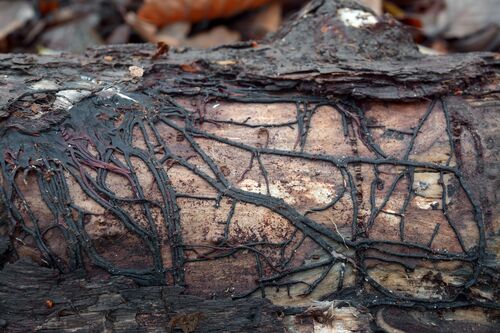
A Diseased Tree Trunk
Causes of Infection
Armillaria Root Rot is caused by a group of soil-borne fungi from the Armillaria genus. These fungi have a saprophytic lifestyle, thriving on decaying organic matter, particularly wood. They enter trees through root wounds or natural root openings, establishing a parasitic relationship that weakens the tree's ability to absorb water and nutrients.
Spread Mechanisms
The spread of Armillaria Root Rot occurs through various mechanisms. Primary sources of infection include infected root systems left behind after tree removal, which continue to host the fungus. Rhizomorphs, also known as shoestring structures, act as fungal highways, facilitating the movement of the pathogen through the soil to neighboring trees. The fungus can also spread through root grafts between adjacent trees, allowing it to move rapidly within a stand or forested area.
Symptoms and Manifestations
Recognizing the symptoms of Armillaria Root Rot is crucial for early detection and intervention. The disease manifests differently based on the tree species, health, and environmental conditions.
Common symptoms include:- Foliage Discoloration: Leaves may exhibit a dull or faded appearance, often turning yellow or brown prematurely.
- Reduced Growth Vigor: Infected trees typically display a decline in growth vigor, leading to stunted growth and reduced canopy density.
- Wilting and Dieback: Branches or sections of the tree may wilt or die, showing signs of decay.
- Presence of Mushrooms: During the fungus's reproductive stage, clusters of honey-colored mushrooms may emerge at the base of infected trees, indicating advanced stages of decay.
Environmental Triggers
Environmental stressors, such as drought, excessive moisture, poor soil drainage, or insect infestations, exacerbate the effects of Armillaria Root Rot. Trees already weakened by these stressors become more susceptible to fungal attack, accelerating the progression of the disease.
Management Challenges: Extensive Underground Networks
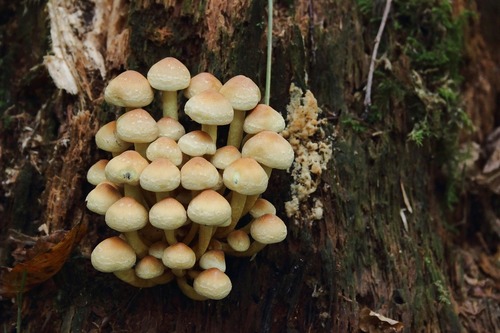
A Cluster of Mushrooms on a Tree Trunk - Image by Siegella on Pixabay
Vast Rhizomorph Networks
Armillaria fungi develop vast underground networks known as rhizomorphs or shoestring structures. These networks consist of interconnected fungal filaments that can extend for significant distances through the soil. Rhizomorphs facilitate the spread of the fungus, enabling it to infect new trees and persist in the environment even after host trees are removed. The size of these networks can span several meters or more depending on the environmental conditions and the duration of fungal presence.
Persistence in Soil
One of the most formidable challenges in managing Armillaria Root Rot lies in the fungus's ability to survive for years in the soil without a host tree. Even after apparent eradication measures, remnants of the fungal network can remain dormant, ready to reinfect susceptible trees when conditions are favorable. This persistence complicates efforts to completely eliminate the pathogen from affected areas.
Difficulty in Eradication
The extensive and resilient nature of Armillaria's underground networks makes eradication efforts challenging. Traditional management approaches, such as removing infected trees or applying fungicides, often prove insufficient in eliminating the fungus entirely. As a result, preventing the spread and minimizing the impact of Armillaria Root Rot becomes an ongoing management concern rather than a one-time solution.
Conclusion
Armillaria Root Rot, a stealthy fungal assailant, silently imperils trees across landscapes. Its prevalence and concealed symptoms underscore the need for understanding and proactive management. This fungal threat, with its enigmatic luminescence and intricate underground networks, poses multifaceted challenges.
The economic impact spans industries, diminishing timber yields, disrupting ecosystem services, and depreciating property values. Combatting this menace requires a collaborative effort, employing proactive measures like disease-resistant species, vigilant site preparation, and healthy tree practices. Arborist Now, equipped with expertise in tree care, stands ready to tackle Armillaria and other tree ailments.
In this delicate balance between nature's complexity and human stewardship, vigilance and expert care offer defenses against Armillaria Root Rot. Through proactive measures and expert guidance, we safeguard the vitality of our cherished trees.
If you think your trees may be infected with Armillaria Root Rot or another tree ailment, contact Arborist Now for an expert assessment.
We may receive affiliate compensation for some of the links below at no cost to you if you decide to make a purchase.
Originally posted on March 22, 2017

